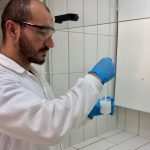Essa célula solar transparente poderia tornar cada janela e tela uma fonte de energia

Em Agosto de 2014, pesquisadores da Michigan State University criaram um concentrador solar inteiramente transparente, que pode transformar qualquer janela ou camada de vidro (como a tela de um smartphone) em uma célula solar fotovoltaica. Ao contrário de outras células solares “transparentes” que foram anunciados no passado, esta realmente é transparente, como você pode ver através das fotos neste artigo. De acordo com Richard Lunt, que liderou a pesquisa na época, a equipe estava confiante que os painéis solares transparentes podem ser efetivamente implantados em uma ampla variedade de ambientes, de “grandes edifícios com muitas janelas ou qualquer tipo de aparelho móvel que demanda uma alta qualidade estética, como um celular ou um tablet de leitura.”
Agora, Ubiquitous Energy, um startup MIT que apresentamos em 2013, está perto de trazer seus painéis solares transparentes ao mercado. Lunt é cofundador da companhia e continua como professor assistente de engenharia química e ciência dos materiais na Michigan State University. Basicamente, o que eles estão fazendo é ao invés de reduzir os componentes, estão mudando a forma como as células absorvem luz. A célula colhe seletivamente a parte do espectro solar que não é visível ao olho humano, enquanto deixa a luz comum visível passar.
Cientificamente, um painel solar transparente é um paradoxo. Células solares, especialmente as fotovoltaicas, geram energia ao absorver fótons (luz do sol) e convertê-los em elétrons (eletricidade). Se o material é transparente, no entanto, por definição significa que toda a luz atravessa o meio para atingir a parte de trás do olho. É por isso que células solares transparentes anteriores têm sido apenas parcialmente transparentes – e para piorar, eles costumam ter uma sombra colorida.

Para superar esta limitação, os pesquisadores da Michigan State usam uma técnica levemente diferenciada para absorção de luz solar. Ao invés de tentar criar uma célula fotovoltaica transparente (o que é quase impossível), eles usam um concentrador solar luminescente transparente (TLSC). O TLSC consiste em sais orgânicos que absorvem comprimentos de ondas especificas não visíveis de luz ultravioleta e infravermelha, que em seguida luminesce (brilha) como outro comprimento de luz infravermelha (também não visível). Essa luz infravermelha emitida é direcionada à borda do plástico, onde tiras finas de células solares fotovoltaicas convencionais convertem-nas em eletricidade. [Papel de pesquisa: DOI: 10.1002/adom.201400103 – “Concentradores solares luminescentes transparentes de coleta quase-infravermelha”]
Se você olhar com atenção, pode ver algumas listras pretas nas bordas da folha de plástico. Apesar disso, o material orgânico ativo – e, portanto, a maior parte do painel solar – é altamente transparente.
O protótipo de TSLC atualmente possui cerca de 1% de eficiência, mas acredita-se que pode chegar a cerca de 10% quando as produções começarem. Concentradores luminescentes não-transparentes (que banham o ambiente em luz colorida) chegam no máximo a 7% de eficiência. Sozinhos eles não significam muito, mas em larga escala – todas as janelas de uma casa ou de uma torre empresarial – os números aumentam exponencialmente. E enquanto nós não estamos falando de uma tecnologia capaz de manter os smartphones funcionando infinitamente, substituir a tela do seu dispositivo por uma TLSC poderia te dar alguns minutos ou horas extras de uso dentro uma bateria.
“Isso abre muitas áreas de implementação de energia solar em uma maneira não-invasiva” Lunt disse em uma entrevista ao blog Michigan State’s Today. “Pode ser usado em grandes edifícios com muitas janelas ou qualquer tipo de aparelho móvel que demanda uma alta qualidade estética, como um celular ou um tablet de leitura. Finalmente, queremos fazer superfícies de coleta de luz solar que você nem ao menos sabe que estão ali”
Os pesquisadores – e a Ubiquitous Energy – estão confiantes que a tecnologia pode ser desenvolvida desde escalas industriais e aplicações comerciais, até aparelhos de consumo, enquanto continua acessível. Até então, um dos maiores obstáculos para adoção de larga escala de energia solar é a aparência intrusiva e feia dos painéis solares – obviamente, se pudermos produzir grandes quantias de energia solar de chapas de vidro e plástico que se parecem com chapas de vidro e de plástico normais, então isso seria incrível.
Texto Original:
Back in August 2014, researchers at Michigan State University created a fully transparent solar concentrator, which could turn any window or sheet of glass (like your smartphone’s screen) into a photovoltaic solar cell. Unlike other “transparent” solar cells that we’ve reported on in the past, this one really is transparent, as you can see in the photos throughout this story. According to Richard Lunt, who led the research at the time, the team was confident the transparent solar panels can be efficiently deployed in a wide range of settings, from “tall buildings with lots of windows or any kind of mobile device that demands high aesthetic quality like a phone or e-reader.”
Now Ubiquitous Energy, an MIT startup we first reported on in 2013, is getting closer to bringing its transparent solar panels to market. Lunt cofounded the company and remains assistant professor of chemical engineering and materials science at Michigan State University. Essentially, what they’re doing is instead of shrinking the components, they’re changing the way the cell absorbs light. The cell selectively harvests the part of the solar spectrum we can’t see with our eye, while letting regular visible light pass through.
Scientifically, a transparent solar panel is something of an oxymoron. Solar cells, specifically the photovoltaic kind, make energy by absorbing photons (sunlight) and converting them into electrons (electricity). If a material is transparent, however, by definition it means that all of the light passes through the medium to strike the back of your eye. This is why previous transparent solar cells have actually only been partially transparent — and, to add insult to injury, they usually they cast a colorful shadow too.
To get around this limitation, the Michigan State researchers use a slightly different technique for gathering sunlight. Instead of trying to create a transparent photovoltaic cell (which is nigh impossible), they use a transparent luminescent solar concentrator(TLSC). The TLSC consists of organic salts that absorb specific non-visible wavelengths of ultraviolet and infrared light, which they then luminesce (glow) as another wavelength of infrared light (also non-visible). This emitted infrared light is guided to the edge of plastic, where thin strips of conventional photovoltaic solar cell convert it into electricity. [Research paper: DOI: 10.1002/adom.201400103 – “Near-Infrared Harvesting Transparent Luminescent Solar Concentrators”]
If you look closely, you can see a couple of black strips along the edges of plastic block. Otherwise, though, the active organic material — and thus the bulk of the solar panel — is highly transparent. (Read: Solar singlet fission bends the laws of physics to boost solar power efficiency by 30%.)
The prototype TLSC currently has an efficiency of around 1%, but they think 10& should be possible once production commences. Non-transparent luminescent concentrators (which bathe the room in colorful light) max out at around 7%. On their own these aren’t huge figures, but on a larger scale — every window in a house or office block — the numbers quickly add up. And while we’re probably not talking about a technology that can keep your smartphone or tablet running indefinitely, replacing your device’s display with a TLSC could net you a few more minutes or hours of usage on a single battery charge.
“It opens a lot of area to deploy solar energy in a non-intrusive way,” Lunt said in an interview with Michigan State’s Today blog. “It can be used on tall buildings with lots of windows or any kind of mobile device that demands high aesthetic quality like a phone or e-reader. Ultimately we want to make solar harvesting surfaces that you do not even know are there.”
The researchers — and Ubiquitous Energy — are confident that the technology can be scaled all the way from large industrial and commercial applications, down to consumer devices, while remaining affordable. So far, one of the larger barriers to large-scale adoption of solar power is the intrusive and ugly nature of solar panels — obviously, if we can produce large amounts of solar power from sheets of glass and plastic that look like normal sheets of glass and plastic, then that would be incredible.



